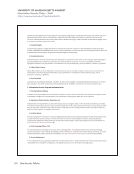29 SPEC Kit 360: Learning Analytics Yes the Office of Information Security places stipulations on all personal, confidential, and sensitive data. Additional comments N=2 I assume that there would be stipulations if we collected identifiers as well, but we do not at this point. The university aligns with relevant government regulations. 24. Please enter any comments you have regarding library use of institutional data. N=10 In the future we may explore linking certain library user data with institutional data for learning analytics purposes. Institutional research provides de-identified student information that library instruction data is matched to based on course enrollment rather than attendance. It is growing but very time consuming, as the library has few sources for usable data that are accessible at this time. Occasionally use public information such as student FTEs. We may need to access personal data to resolve account issues. See above. We often use data from Institutional Research to identify the demographics of students, faculty, and staff who use library services and resources or who participate in library studies (e.g., surveys, focus groups). The library often obtains institutional data by request to Information Technology Services. This is an area we hope to grow into in the future in terms of strategically streamlining library and institutional data where it makes sense, such as perhaps embedding the library into the early alert system for students. We are not doing this yet. We want to move in this direction. We’re looking at enrollment data for course related interactions and possible collections correlations in the future. DATA PROTECTIONS 25. Please indicate which of the following data protections the library applies to its learning analytics projects. Check all that apply. N=40 Limit library staff access to raw data 39 98% Remove direct identifiers from data (e.g., removing student ID number) 34 85% Limit scope of data collection 31 78% Technical security protections during data storage (e.g., encrypting datafiles in a cloud system) 26 65% Physical security protections (e.g., locking up paper forms) 24 60% Limit library staff access to analyzed data 24 60% Delete data 20 50% Limit data retention 18 45% Technical security protections during data transfer (e.g., encrypting datafiles sent over email) 13 33%































































































































































